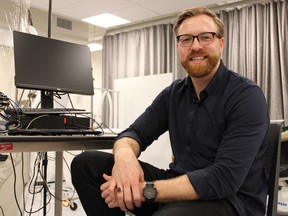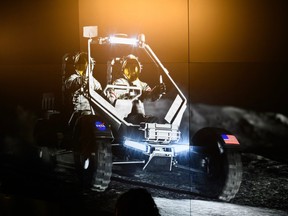Calgary scientist conducting research with NASA to bolster astronauts' health on long missions
'NASA has the Artemis program, which has the goal of putting astronauts back on the moon in the next couple of years. And so, the challenge is no longer if we can do it — it's doing it safely for longer durations'

Article content
A Mount Royal University biologist is partnering with NASA and the German Space Agency to conduct research that will help astronauts maintain their health during prolonged space missions.
“NASA has the Artemis program, which has the goal of putting astronauts back on the moon in the next couple of years. And so, the challenge is no longer if we can do it — it’s doing it safely for longer durations,” said Nick Strzalkowaski, who holds a PhD in neurophysiology and a bachelor of science in human kinetics.
Strzalkowaski is collaborating with primary investigator Leah Bent of the University of Guelph and co-investigator Ryan Peters from the University of Calgary to study skin sensitivity changes in participants spending 60 days in head-down bed rest to better understand sensory adaptations that occur during space flight. The project is financially supported by the Canadian Space Agency.
“The goal of the big project that I’m involved in is to investigate countermeasures to see if we can slow down or mitigate the physiological adaptations in the space environment.”
The research will consist of four campaigns of 12 participants, which will take a couple of years to complete; the first round of testing will take place in September.
“What’s amazing about this project is that there are dozens of principal investigators doing dozens of different experiments because of how complex and invasive the head-down bed rest protocol is, so it’s really cool to be part of this really massive team.”

Weightlessness can have serious impact on health of astronauts
Being subjected to the effects of microgravity is one of the first things to happen when someone goes to space. Microgravity causes blood and other fluid to shift upwards toward the head, causing puffiness in the face, putting pressure on the eyes and the optic nerves, and causing vision impairments.
“It also puts stress on the cardiovascular system — your heart doesn’t have to work as hard, so it shrinks and you lose blood volume. Floating out in space also means you’re not using your muscles, so you have muscle atrophy or weakening, which can lead to osteoporosis-like symptoms and kidney stones,” Strzalkowaski said.
And while testing astronauts in space is expensive, dangerous, and challenging, conducting research on Earth to study physiological adaptations that occur is a much safer and more cost-effective option.
“That’s where the head-down bed rest comes in, and that simulates the fluid shifts because their head is down at six degrees and below their feet, and it’s unloading so they’re not using their muscles and their bones.”
The inspiration for the project came from work that Strzalkowaski and primary investigator Bent did back in 2011 in another NASA study looking at changes in foot sole sensitivity in astronauts.
“The advantage of doing the head-down bed rest study is that now we can test these participants multiple times — so instead of just pre-post, we can look at them, for example, on day three and day seven, and at two-week increments over the protocol to see how these changes occur over time.
“Space research, even if the goals are about space exploration, the findings and discoveries do make their way back to Earth. So, it’s everything from scratch-resistant lenses to artificial limbs to air purification systems, water purification systems, and GPS — all that stuff started with a space application and then came back to Earth,” Strzalkowski said.
April 12 marks the International Day of Human Space Flight.








Postmedia is committed to maintaining a lively but civil forum for discussion. Please keep comments relevant and respectful. Comments may take up to an hour to appear on the site. You will receive an email if there is a reply to your comment, an update to a thread you follow or if a user you follow comments. Visit our Community Guidelines for more information.